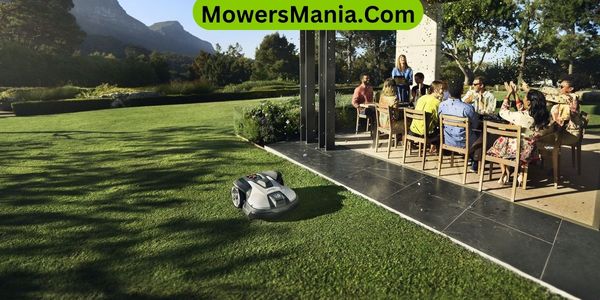Picture a sleek, futuristic machine effortlessly gliding across your lawn, meticulously trimming every blade of grass with precision.
You might wonder, why do robot mowers come with such a hefty price tag?
Well, one key factor lies in the intricate web of advanced technology that powers these autonomous lawn care assistants.

But that’s just the beginning of the story.
By uncovering the layers of expertise and innovation that contribute to their cost, you will gain a deeper understanding of why investing in a robot mower is not just buying a product but a piece of cutting-edge technology.
Advanced Technology Costs
When considering robot mowers, the advanced technology costs can significantly impact the overall investment.
These robot mowers are equipped with state-of-the-art features such as GPS navigation, obstacle detection sensors, and automated scheduling capabilities.
While these technologies provide convenience and efficiency, they also contribute to the higher price tag of robot mowers compared to traditional lawn mowers.
The GPS navigation system allows the robot mower to map out the cutting area, ensuring precise and methodical mowing patterns.
This feature not only saves you time but also ensures that every inch of your lawn is evenly trimmed.
Additionally, obstacle detection sensors help the robot mower navigate around trees, flower beds, and other objects in the yard, preventing accidents and damage to both the mower and your landscaping.
Moreover, the automated scheduling capabilities enable you to set specific mowing times, ensuring that your lawn is consistently maintained without any manual intervention.
While these advanced technologies come at a cost, the convenience and time-saving benefits they provide make robot mowers a worthwhile investment for many homeowners.
Precision Engineering Expenses
Investing in precision engineering for robot mowers may incur additional expenses, but it ensures optimal performance and durability in maintaining your lawn.
These mowers are built with intricate components that require high levels of accuracy during production.
The precision engineering involved in their design and manufacturing processes contributes significantly to their overall cost.
The precision engineering expenses are justified by the benefits they bring. The intricate sensors, motors, and blades in robot mowers require meticulous engineering to work seamlessly together.
This precision ensures that the mower can navigate your lawn efficiently, avoiding obstacles and cutting grass with precision.
Moreover, the durability of a robot mower is closely tied to its precision engineering. Components that are precisely designed and manufactured are less likely to fail prematurely, leading to fewer repairs and replacements in the long run.
While these precision-engineered parts may increase the initial cost of the mower, they ultimately contribute to its longevity and performance, making them a worthwhile investment for maintaining a well-manicured lawn.
Quality Materials Impact Pricing

When purchasing a robot mower, it’s essential to consider the impact of quality materials on pricing. High-quality materials often come with a higher price tag due to their durability and performance.
These materials also contribute to the overall manufacturing expenses, influencing the final cost of the robot mower.
Material Costs
Using high-quality materials in robot mowers significantly impacts their pricing. When you invest in a robot mower, you’re paying not just for the technology, but also for the durable components that make up the machine.
Here are some ways material costs influence the pricing of robot mowers:
- Durability: Quality materials ensure that the robot mower can withstand various weather conditions and terrain types, increasing its lifespan.
- Performance: High-grade materials contribute to the overall performance of the mower, allowing it to operate efficiently and effectively.
- Reliability: With superior materials, the robot mower is less likely to experience breakdowns or malfunctions, providing you with a reliable lawn care solution.
- Safety: Premium materials enhance the safety features of the robot mower, giving you peace of mind while it operates autonomously.
Manufacturing Expenses
Quality materials play a crucial role in determining the manufacturing expenses of robot mowers, directly impacting their pricing.
When manufacturers opt for high-quality components like durable blades, robust motors, and weather-resistant casings, the initial production costs rise significantly.
These premium materials ensure longevity and performance, but they come at a price during the manufacturing stage.
The precision engineering required to work with top-tier materials adds complexity to the production process, further contributing to the overall expenses.
Additionally, stringent quality control measures are often implemented to maintain the high standards associated with these materials, leading to higher manufacturing costs.
Therefore, while the upfront investment in quality materials may increase the manufacturing expenses of robot mowers, it ultimately reflects in the product’s reliability and longevity.
Research and Development Investments
When considering robot mowers, you might wonder about the high-tech components that contribute to their pricing.
The testing and refinement process, along with the continuous innovation in materials, are key aspects impacting research and development investments in this field.
It’s important to understand how these factors influence the overall cost and functionality of these advanced lawn care devices.
High-Tech Components Cost
Investing in research and development for high-tech components of robot mowers can significantly impact their overall cost.
Manufacturers dedicate resources to developing cutting-edge technology that enhances the efficiency and performance of robot mowers.
This investment in innovation contributes to the higher price tag of these machines, but it also brings numerous benefits to users.
- Sophisticated sensors and navigation systems improve precision and accuracy.
- Advanced battery technology ensures longer operating times and faster recharging.
- High-quality materials increase durability and resistance to wear and tear.
- Constant software updates and improvements enhance functionality and user experience.
Testing and Refinement Process
During the testing and refinement process of robot mowers, manufacturers focus on optimizing performance and enhancing user experience through continuous innovation.
This stage involves rigorous testing under various conditions to ensure the robot mower can navigate different terrains, handle obstacles effectively, and deliver precise cutting results.
Manufacturers invest significantly in research and development to fine-tune the technology, improve sensors for better object detection, enhance battery efficiency for longer operation times, and refine software algorithms for smarter navigation.
By constantly refining these aspects, manufacturers can offer consumers a reliable and efficient product that meets their lawn maintenance needs.
The commitment to testing and refinement is essential to producing high-quality robot mowers that justify their cost through performance and durability.
Innovation in Materials
Manufacturers prioritize researching and developing innovative materials to enhance the performance and durability of robot mowers. By investing in research and development, they aim to push the boundaries of what robot mowers can achieve.
Here are some key areas where manufacturers focus their innovation efforts:
- Lightweight High-Strength Alloys: Improving maneuverability without sacrificing durability.
- Weather-Resistant Coatings: Enhancing longevity in various climates.
- Self-Repairing Components: Minimizing maintenance needs and downtime.
- Environmentally-Friendly Materials: Aligning with sustainable practices and regulations.
These advancements not only improve the functionality of robot mowers but also contribute to their long-term value and efficiency.
Maintenance and Support Expenses
Considering the ongoing maintenance and support expenses associated with robot mowers, budgeting for these costs is crucial for optimal performance and longevity.
Regular maintenance tasks such as blade replacement, battery checks, software updates, and cleaning are essential to ensure that your robot mower continues to operate efficiently.
Additionally, having access to reliable customer support in case of technical issues or malfunctions is key to maximizing the lifespan of your investment.
To give you a clearer picture of the potential maintenance and support expenses, here is a breakdown:
| Maintenance Task | Frequency | Estimated Cost |
|---|---|---|
| Blade Replacement | 1-2 times/year | $20-$50 |
| Battery Replacement | 2-4 years | $100-$300 |
| Software Updates | As needed | Free or minimal |
| Customer Support | As needed | Included in purchase |
Increased Demand Influences Pricing

As customer interest surges, the pricing of robot mowers is increasingly influenced by market demand. This spike in demand has a direct impact on the costs associated with purchasing a robot mower.
Here’s why:
- Supply and Demand Dynamics: As more people seek robot mowers, manufacturers may struggle to keep up with the sudden increase in orders. This imbalance between supply and demand can drive prices higher.
- Research and Development Costs: With increased demand comes a need for continuous innovation. Manufacturers invest heavily in research and development to enhance their products, which can lead to higher pricing to cover these expenses.
- Economies of Scale: While demand is high, the scale of production may not have caught up yet. Mass production can help lower costs, but until then, prices may remain elevated.
- Competitive Market: The competitive landscape plays a significant role. High demand may lead to more players entering the market, but competition doesn’t always result in lower prices immediately.
Frequently Asked Questions [FAQs]
Are Robot Mowers More Expensive Than Traditional Lawn Mowers in the Long Run?
In the long run, robot mowers can be more expensive than traditional lawn mowers due to higher upfront costs. However, they offer convenience and time savings, potentially reducing maintenance and labor expenses over time.
How Do Advancements in Artificial Intelligence and Sensors Affect the Cost of Robot Mowers?
Advancements in artificial intelligence and sensors contribute to the cost of robot mowers. These technologies enhance efficiency and autonomy, enabling precise navigation and improved performance, resulting in higher prices for these innovative lawn care devices.
Are There Any Government Subsidies or Incentives Available for Purchasing a Robot Mower?
Government subsidies or incentives for purchasing a robot mower vary by location. Research online or contact local agencies for information. These programs might help offset the cost and promote environmentally friendly lawn care practices.
What Are the Environmental Benefits of Using a Robot Mower Compared to Traditional Alternatives?
Using a robot mower over traditional alternatives benefits the environment by reducing air and noise pollution. It operates quietly and emits no harmful emissions, contributing to a healthier and greener lawn care solution.
How Do Different Brands and Models of Robot Mowers Vary in Price and Features?
When considering different brands and models of robot mowers, prices and features vary significantly. You should research thoroughly to find the best fit for your needs and budget. Compare options before making a decision.
Conclusion
So, now you understand why robot mowers are so expensive. Advanced technology, precision engineering, quality materials, research and development, maintenance and support, and increased demand all contribute to the higher price tag.
While it may seem like a big investment upfront, the convenience and time-saving benefits of a robot mower can outweigh the cost in the long run. Just think of it as a worthwhile investment in your lawn’s future.



